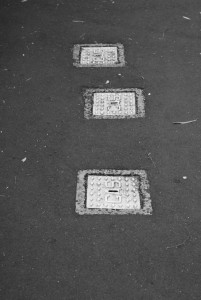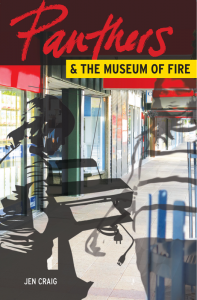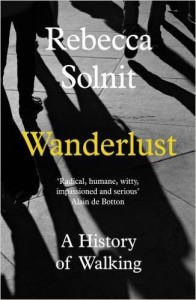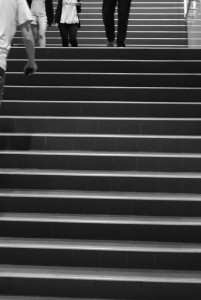 “It’s an unseasonably warm day at the beginning of May, rays of sunlight are filtering through the leaves of a towering Moreton Bay Fig tree. I sit on a park bench waiting at the top of Glebe Point Park for Sydney author Jen Craig.” Recent USyd M.A. in Publishing grad, Alyssa Hanley takes an entertaining and informative stroll with Jen Craig, author of Panthers and the Museum of Fire in this essay, Talking and Walking: Sydney Literary Culture.
“It’s an unseasonably warm day at the beginning of May, rays of sunlight are filtering through the leaves of a towering Moreton Bay Fig tree. I sit on a park bench waiting at the top of Glebe Point Park for Sydney author Jen Craig.” Recent USyd M.A. in Publishing grad, Alyssa Hanley takes an entertaining and informative stroll with Jen Craig, author of Panthers and the Museum of Fire in this essay, Talking and Walking: Sydney Literary Culture.
A woman in a floaty, flower-dappled purple blouse comes towards me with a big smile and a broad wave. Today we have met to recreate the journey that takes place in her 2015 Spineless Wonders published book, Panthers and the Museum of Fire. Map this journey, if you will, through the leafy inner-city suburb of Glebe following Glebe Point Road, down the hustle and bustle of busy Broadway, under the echoey tunnel that runs subterrain to Central Station and up the steep and shadowy incline of Foveaux Street in Surry Hills.
After exchanging cordial introductions, Jen and I start off on our journey. As we ascend a small hill our conversation begins to pick up pace, matching the speed of our strides as we pass “those tasteful, box-shaped hedges that Glebe is full of” (Craig, 2015: 4). Sitting to have an interview with an author is somewhat of a stifling experience and walking was indeed the only way to conduct an interview with this energetic Sydney author.
I confess to Jen that I moved to Sydney only 16 months ago from Brisbane and found that I really began to connect with the city through walking its streets and circumnavigating the inner-city paths. With the fresh and excited eyes of someone seeing things for the first time, I began to feel a strong connection between discovering this city and reading its literature.
Nietzsche argued that philosophy and fresh air were connected. “Do not believe any idea that was not conceived while moving around outside with your muscles in a celebratory mode. Sitting down is the true sin against the Holy Spirit.” (More, 2014: 89). Walking is one of life’s great simple pleasures, and some of literature’s most iconic authors have utilised the humble walking journey to construct narrative direction. William Wordsworth, Jane Austen, James Joyce and Gertrude Stein were all big walkers who wrote about walking journeys through their various literary forms (Gleeson, 2015).
Panthers follows the narrator, Jen, on a journey through Glebe in Sydney’s inner west towards Surry Hills as she carries with her the manuscript of a childhood friend who has recently died. Her thoughts surge between past and present as she strives to understand the effect her friend’s manuscript Panthers and the Museum of Fire, has had on her. The journey is a backdrop to the filtered thoughts and emotional journey of Jen, which scratches the descriptive surface of the visual cityscape between two relatively obscure points within Sydney.
Rebecca Solnit, author of Wanderlust: A History of Walking points out that “most modern writers are deskbound, indoor creatures when they write, and nothing more than outline and ideas can be achieved elsewhere.” (Solnit, 2000: 113). Craig’s method for writing Panthers seems to me to hark back to Indigenous Australian oral traditions and their strong connection with walking and the land. This may in part explain why her work has the casualness of a conversation. You feel the forward momentum in the book, the inner monologue of the narrator, much like Jen Craig is reading it aloud to you, over your shoulder.
Much to my surprise, Craig confesses that she had never even taken this journey herself until after the book was published. Instead she mapped it all out in her head, and pieced together fragments of her own memory with historical construction of particular buildings and shops that she had always been fond of.
While starting at the top of Glebe Point Park she walks me past a dowdy concrete block that she imagined her narrator resides in. It comes to light that a friend of hers had been attacked there in a home invasion in the 80s and this sets a new precedent for how I come to see the main character.
We emerge from the backstreets, walking into the noise and the wind of Glebe Point Road. I quickly discover that Jen is indeed a great walker and that I am gullible and trusting of traffic to stop at pedestrian crossings, almost being hit by a car a mere 15 minutes into our journey. I make it to the narrow path safely while the car horn blares angrily at me. “As if immune to what had very nearly happened – the end of my being” (Craig, 2015: 98), Jen delicately touches a hand to my shoulder and says, “this is the bit that I wrote about. It’s a bit precarious and even described as being very narrow in Panthers and it happens to be the one that the narrator runs across in the book.”
 The irony that I had a near death experience very similar to the one the narrator experiences in Panthers is uncanny. Indeed, in some streets “you take your life in your hands” (Craig, 2015:19) and “dice with death” (ibid, 2015:27) itself if there is no pedestrian crossing or flashing red lights to protect you from the oncoming traffic.
The irony that I had a near death experience very similar to the one the narrator experiences in Panthers is uncanny. Indeed, in some streets “you take your life in your hands” (Craig, 2015:19) and “dice with death” (ibid, 2015:27) itself if there is no pedestrian crossing or flashing red lights to protect you from the oncoming traffic.
As we get closer to the corner of Glebe Point Road and Parramatta Road, the noise builds slowly into a long continuum of scraping and squealing (Craig, 2015:14). While Jen Craig named the narrator and character Jen Craig after herself, it is not a straightforward autobiographical work. The Jen Craig that stands in front of me is an effervescent mother and wife, has a relaxed demeanor and is one of those people who is immediately likeable. However, the Jen Craig character in the book is single, childless, obsessive, unlikeable and very alone. There are even small fictionalisations of the character, such as Jen does not actually live in Glebe or work in radio. This fusing of memoir with fiction, blurs the boundaries of fiction and non-fiction, and forces the reader to really question what is real and what is created by the author.
Jen Craig has managed to create an alternative world for her first person ‘I’ to reside. This enables her to utilise the inner monologue as a space to discuss her own personal journey with anorexia and open a discussion on living with an eating disorder and the personal journey in her own body that is reflected in the pages.
At first, I felt that the interior discussion of body image was out of place with the book, but upon reflection on Wanderlust, Rebecca Solnit’s musings make a great deal of sense in terms of Panthers.
The path is an extension of walking, the places set aside for walking are monuments to that pursuit, and walking is a mode of making the world as well as being in it. Thus the walking body can be traced in the places it has made, paths, parks, and sidewalks are traces of the acting out of imagination and desire, walking sticks, shoes, maps, canteens, and backpacks are further material results of that desire. Walking shares with making and working that crucial element of engagement of the body and the mind with the world, of knowing the world through the body and the body through the world. (Solnit, 2000: 29)
I observe Craig walking for a moment and consider her confident, long strides. Her red leather sandals hit the dirty sidewalk with a spring and she gracefully weaves her way around people waiting next to cafes for their takeaway coffees. It’s impossible to tell from face value that she has struggled with an eating disorder, but bringing a discussion as heavy as anorexia into Panthers gives the work a depth and complexity that were clearly born out of hardship and personal experience.
The conversation halts while a dump truck passes and drowns out all other noise around us, its full load is pungent and we simultaneously cover our noses with our hands. In this moment I reflect upon something that didn’t strike me until a second reading of Panthers. There is a very subtle exclusion of direct dialogue within the book, as all of the conversations with friends are framed within memories and thought processes. Craig hops between the timeline within the book by using connective words such as, “I was remembering” or “I was thinking back” to connect the past with the present journey that she is on. She effortlessly intertwines descriptive snippets of Sydney with the narrator’s internal monologue.
We bob and weave through the ever-growing number of pedestrians making their way about Broadway, discussing various Australian authors’ works that have influenced her writing including Christina Stead, Delia Falconer, and David Malouf. “In fact, David just lives around the corner here. We could pop in to say hello if we had time,” Jen says pointing past the monolithic Lansdowne Hotel. The Lansdowne is a big, grungy, quintessentially Sydney pub on the corner of Broadway and City Road, the one that looks as though decades of spilt beers have seeped through the carpet only to leave an insipid, lingering stench. There are a lot of old pubs on this street, “marinating in their own history,” as Craig puts it. Suddenly loud whooping sirens wail and scream past, interrupting our discussion. Several fire-engines part the seas of traffic as car horns beep and pull to the side in an inconvenienced manner. Perfect timing to ask Jen to reflect upon what it means to write about Sydney.
While Jen is a native North-Shore Sydney-sider, she did not set out to write a book about Sydney, but merely as a familiar backdrop to the narrator’s personal journey. However, Panthers does indeed show an unfettered vision of Sydney, untouched by the tourist eyes of the popular harbour city. Instead, Jen’s book shows the everyday residents’ Sydney, with a smutty reality that portrays Sydney’s disgusting side. Panthers could easily be a view of Sydney unrecognizable to people that were not intimately familiar with its terrain.
I think I have really great ideas and really great conversations when I’m walking, that don’t get to make it to paper. But this book is like reading Jen’s thoughts in real-time. Craig argues that Panthers shows an almost blinkered reality because of internalised thoughts and the walk only scratches away between two obscure points. The reader gets to see snippets and flashes of architecture and the physical journey, much like when we run over a busy street only to look to the left and see a panoramic shot of Sydney’s metropolitan cityscape.
Making our way “along Broadway towards the intersection at Regent Street, with the pub and the building that I’ve always thought looked like an icing-covered building” (Craig, 2015: 43) it becomes apparent that Jen has inadvertently created a type of living historical documentation of this portion of Sydney in writing this book set during a certain time. Craig muses that this was unintentional. “It’s certainly not what I intended to do. But by writing it at the time that I did and trying to catch those moments that I did, it ended up being historical.” Panthers captured the changing visual landscape of the ever-changing face of Broadway, before the UTS monolith, before the great garden building, before the older pubs were modernised.
 We discuss Delia Falconer’s personal memoir Sydney and how it sheds light on Sydney’s dark and shadowy past. This in turn affects certain areas that we want to walk and our preconceived notions of certain buildings and street corners. Although Sydney itself has changed, and evolved an air of gentrification through most of its inner-city suburbs, “there are still places in the city of such forbidding gloominess,” (Falconer, 2010: 57). These shadows endure because they reflect Sydney’s wild undertow. This wildness in itself is reflective through its streets and the literature of Sydney.
We discuss Delia Falconer’s personal memoir Sydney and how it sheds light on Sydney’s dark and shadowy past. This in turn affects certain areas that we want to walk and our preconceived notions of certain buildings and street corners. Although Sydney itself has changed, and evolved an air of gentrification through most of its inner-city suburbs, “there are still places in the city of such forbidding gloominess,” (Falconer, 2010: 57). These shadows endure because they reflect Sydney’s wild undertow. This wildness in itself is reflective through its streets and the literature of Sydney.
“The very word street has a rough, dirty magic to it, summoning up the low, the common, the erotic, the dangerous, the revolutionary. A man of the streets is only a populist, but a woman of the streets is like a streetwalker, a seller of her sexuality.” (Solnit, 2000: 176).
I discussed with Jen my own worries about walking through what I thought were unsultry streets of the city on my own. Surry Hills does have a shady past and is intimidating to navigate for a young woman venturing into the big city for the first time. Jen says that she recognizes the seedy side of Sydney with “those buildings with the dark brick and the horizontal stripes, for a long time there was this association with old and ugly factories” but they are just gradually being changed and modernised and it is changing how we see a building like that.” And indeed, neighborhoods that used to be considered dodgy or shady are now very much gentrified, with trendy bars, cafes and young professionals with their small apartment dogs. As Solnit describes the streets as “repositories of history, walking is a way to read that history.” (Solnit, 2000:191).
The modern resident of Sydney likes to “deny [or ignore] its history of want [and hardship], and often forgets that it was a Victorian city with pockets of extreme disadvantage, complete with ‘Ragged Schools’ that educated working children at night.” (Falconer, 2010: 178). Indeed, I had no idea the hardship felt through Sydney’s residential ancestors and upon learning of these tough years I began to fall more in love with the city.
We descend underground into the tunnel under Central Station, just like the typical 150,000 Sydney residents that head through this tunnel on any given day. There is “this need to weave among [the commuters], to make [our] way against the tide of people coming into the city and up the ramp from Central Station, so that [we] might not crash [our] bodies into any of them, this weaving taking all of my concentration for a moment” (Craig, 2015: 74). Within the tunnel, a “man with [an] unknown instrument in a stickered-over case (a kind of lyre, I thought as I recalled what I had seen in his hands, or a flat kind of harp) was beginning to play something that could have been jazz unless it were another busker playing, someone I had failed to notice.” (Craig, 2015: 89).
Our footsteps resonate within the tunnel, and one particular passage in Panthers springs to my mind:
To walk was the ultimate pleasure, the only existence possible – I have attempted to understand my self by taking walks and I have always arrived somewhere with apparently more simply formulated thoughts and a sense that thinking is possible, and that I know what I’m doing or at least what I have been trying to do, I make connections as I walk, I was realising as I got closer and closer to the end of the tunnel, and I am always being buoyed by the unexpected, serendipitous connections between one train of thought and another, and yet the connections between one train of thought or another, and yet the connections that I fashion in my brain through the repetition, inevitable rhythm of my walking could well have no reality, no veracity, I was realising, or trying to realise, outside these peculiar ambulatory conditions of my mind […] (Craig, 2015: 90).
Ignoring the escalator and choosing the stairs to ascend out of Central tunnel, we emerge into the light of the now midday sun. Now in Surry Hills, this side of the city immediately feels a bit more relaxed in comparison to the bustle of Broadway. There is less traffic and office workers are relaxing on their lunch-breaks. We begin the sharp ascent of Foveaux Street.
I pushed myself to walk up the sloping street despite my enormous tiredness now and the blisters that had definitely burst on my heels; to keep walking, when every step slices into my flesh, even to the bone, I was thinking – to continue on my way up what has to be a forty-five degree include, soon to arrive at the corner of the street that is supposed to have the café on it. (Craig, 2015:111).
 We reach the summit, more than a little out of breath. I expect to see the gleaming café I had read about in the book, but in fact, there never was any café on the top of the hill of Foveaux Street. Where Jen had imagined the cafe to be in the book there was an unappealing townhouse desperately in need of a refurbish. We find a theoretical café to end our walk. Jen decides that this quaint café called Cup Half Full on the corner of Crown and Foveaux will suffice. I switch off my audio recorder and order a double shot skim latte to have here, just as Jen does in the book.
We reach the summit, more than a little out of breath. I expect to see the gleaming café I had read about in the book, but in fact, there never was any café on the top of the hill of Foveaux Street. Where Jen had imagined the cafe to be in the book there was an unappealing townhouse desperately in need of a refurbish. We find a theoretical café to end our walk. Jen decides that this quaint café called Cup Half Full on the corner of Crown and Foveaux will suffice. I switch off my audio recorder and order a double shot skim latte to have here, just as Jen does in the book.
Photography by Bettina Kaiser
References
Andrews, A. (2015). “Q and A with Jen Craig.” Accessed from: https://shortaustralianstories.com.au/q-a-with-jen-craig/
Craig, J. (2015). Panthers and the Museum of Fire. Spineless Wonders: Sydney.
Falconer, D. (2010). Sydney. University of Sydney Press: Sydney.
Gleeson, S. (2015) ABC Radio National Podcast. Walking and Writing. 25 August 2015. Accessed from: http://mpegmedia.abc.net.au/rn/podcast/2015/08/eot_20150825_1135.mp3
Maddox, G. (2016). “Subterranean Sydney: the city’s secret life below the surface.” Sydney Morning Herald. June 26, 2016. Accessed from: http://www.smh.com.au/nsw/subterranean-sydney-the-citys-secret-life-below-the-surface-20151202-gldgqs.html
Mode, N. D. (2014). Nietzsche’s Last Laugh: Ecce Homo as Satire. Cambridge University Press: Cambridge.
Solnit, R. (2000). Wanderlust: A History of Walking. Penguin Books: New York.

